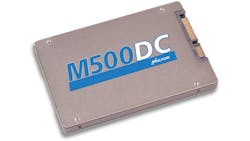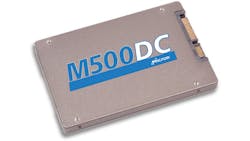Flash storage is not created equal. In addition to a mix of SLC (single level cell), MLC (multi-level cell) and TLC (triple level cell) there are controller considerations and other issues that can affect how a flash device operates over its lifetime and how long that lifetime will be. The differences can be especially important when considering enterprise or embedded applications.
In incorrect choice can lead to drives that expire too early or cost too much compared to the performance and lifetime that they deliver. All flash drives have a limited write lifetime. This tends to have less of an impact for consumer applications where data is normally read. There are enterprise and embedded applications where this is the case as well. Higher capacity TLC products that have a more limited write lifetime work well in this case.
Micron’s M500DC Enterprise SATA SSD (Fig. 1) is optimized for data center appliances and enterprise storage applications that require 1 to 3 drive fills per day. The M500DC uses MLC flash to provide a balanced capacity/write lifetime capability. They are designed to deliver this performance over a five year period.
The family includes 1.8-in and 2.5-in form factors with capacities that range from 120 Gbytes to 800 Gbytes. The M500DC family has a low total cost of ownership in addition to being low power drives. The drivers work very well in big data and content delivery applications (Fig. 2).
The drives are rigorously tested by a trusted NAND supplier. They have ECC support designed for high reliability in mission critical applications. The M500DC supports Micron’s XPERT (eXtended Performance and Enhanced Reliability Technology) feature set that helps to maximize throughput and reduce bottlenecks. XPERT features includes ARM/OR, RAIN, DataSafe and ReCAL support.
Adaptive Read Management/Optimized Read (ARM/OR) is a proactive. It transparently samples stored data and dynamically tunes the flash in the background. The tuning, based on Micron-specified thresholds and it provides additional protection.
Redundant Array of Independent NAND, or RAIN, is implemented using parity information beyond usual error correction code (ECC) support. This is implemented in the drive’s controller.
Micron’s DataSAFE technology protects user data as it moves from the host through the SSD interface to the NAND flash. It embeds the host logical block address (LBA) with the host data before storing it. This additional metadata information helps to ensure that the correct data is being read.
The Reduce Command Access Latency (ReCAL) feature lowers the maximum command/access latency by managing internal operations at a more granular level.
The M500DC has a 6 Gbit/s SATA interface. It has 0.5 ms/1.5 ms read/write latency. The drives use under 6 W except the 800 Gbyte version that uses less than 6.3 W. Sequential read/write performance is 425/375 Mbytes/s. The 480 Gybte version delivers 63,000/35,000 IOPS (read/write).
About the Author
William G. Wong
Senior Content Director - Electronic Design and Microwaves & RF
I am Editor of Electronic Design focusing on embedded, software, and systems. As Senior Content Director, I also manage Microwaves & RF and I work with a great team of editors to provide engineers, programmers, developers and technical managers with interesting and useful articles and videos on a regular basis. Check out our free newsletters to see the latest content.
You can send press releases for new products for possible coverage on the website. I am also interested in receiving contributed articles for publishing on our website. Use our template and send to me along with a signed release form.
Check out my blog, AltEmbedded on Electronic Design, as well as his latest articles on this site that are listed below.
You can visit my social media via these links:
- AltEmbedded on Electronic Design
- Bill Wong on Facebook
- @AltEmbedded on Twitter
- Bill Wong on LinkedIn
I earned a Bachelor of Electrical Engineering at the Georgia Institute of Technology and a Masters in Computer Science from Rutgers University. I still do a bit of programming using everything from C and C++ to Rust and Ada/SPARK. I do a bit of PHP programming for Drupal websites. I have posted a few Drupal modules.
I still get a hand on software and electronic hardware. Some of this can be found on our Kit Close-Up video series. You can also see me on many of our TechXchange Talk videos. I am interested in a range of projects from robotics to artificial intelligence.



